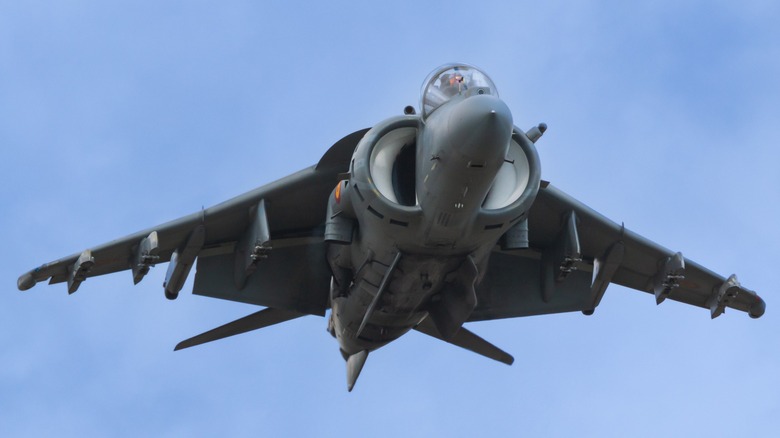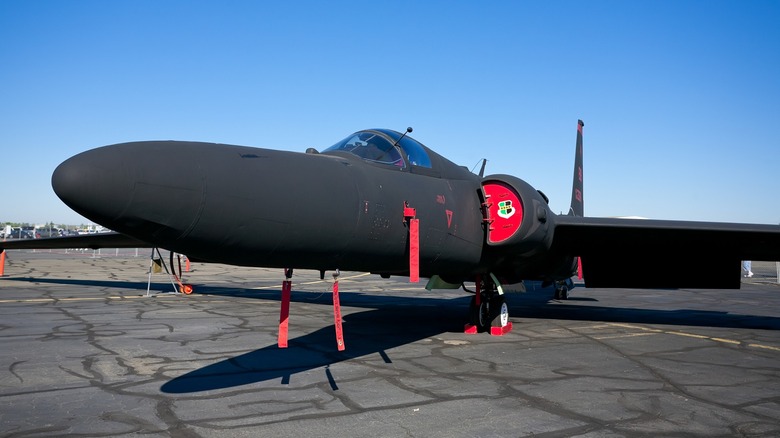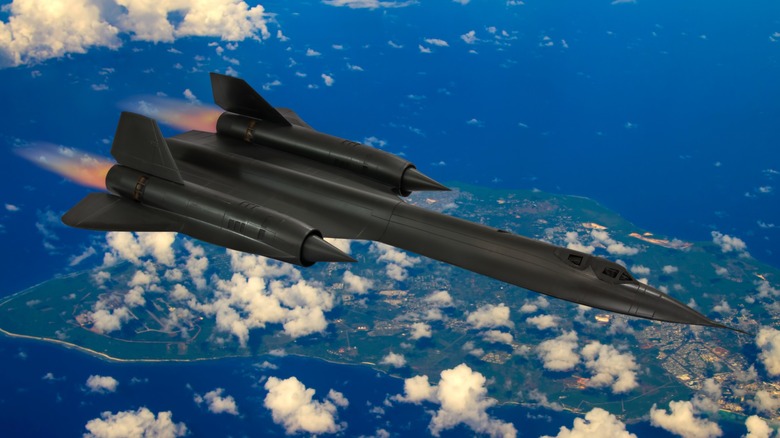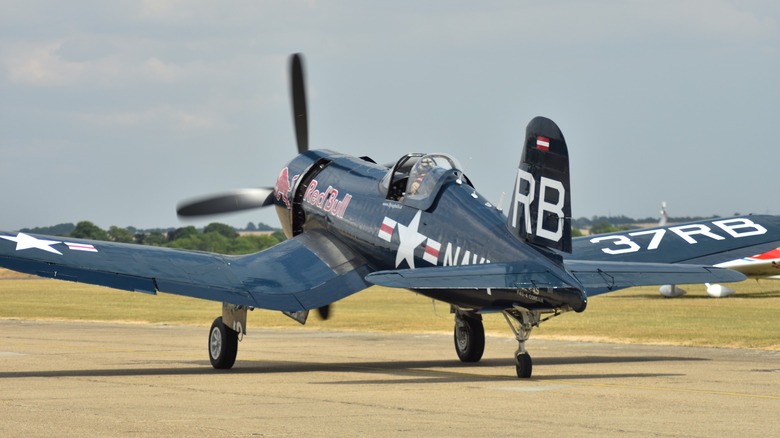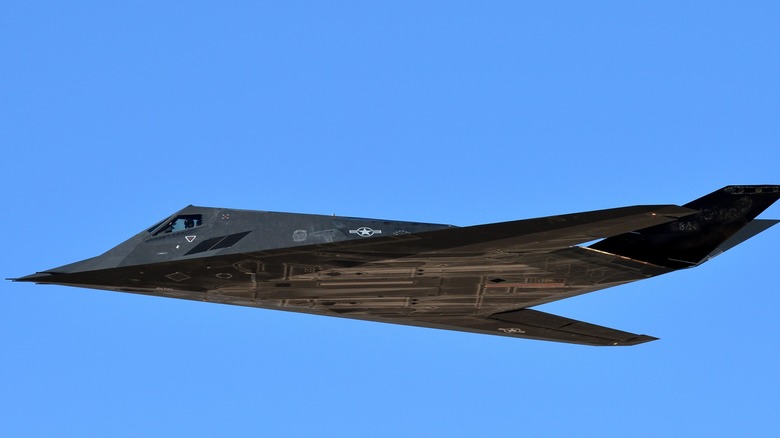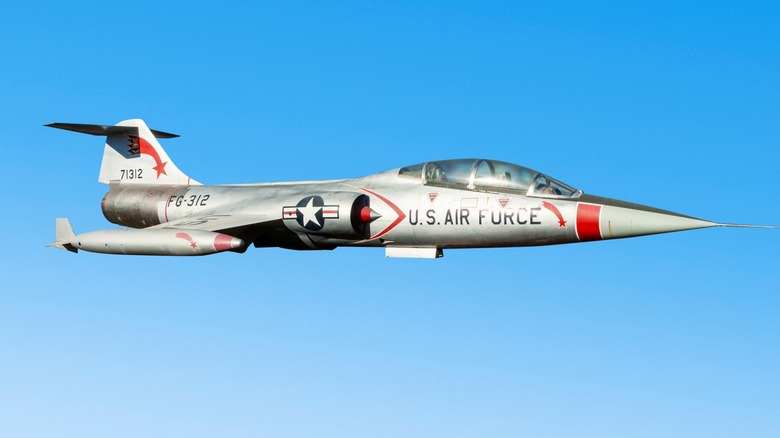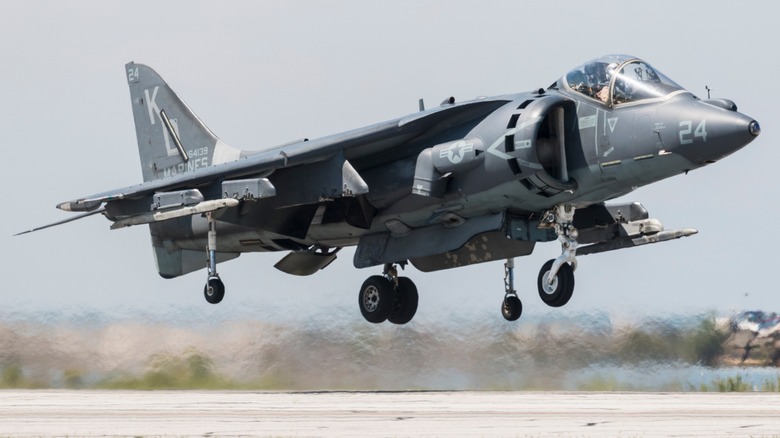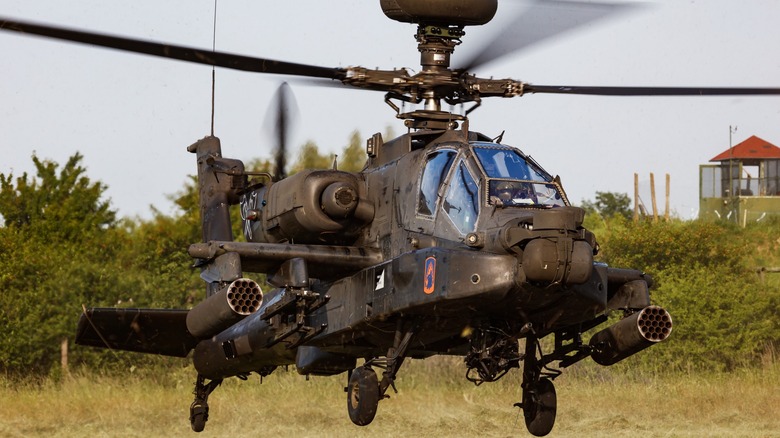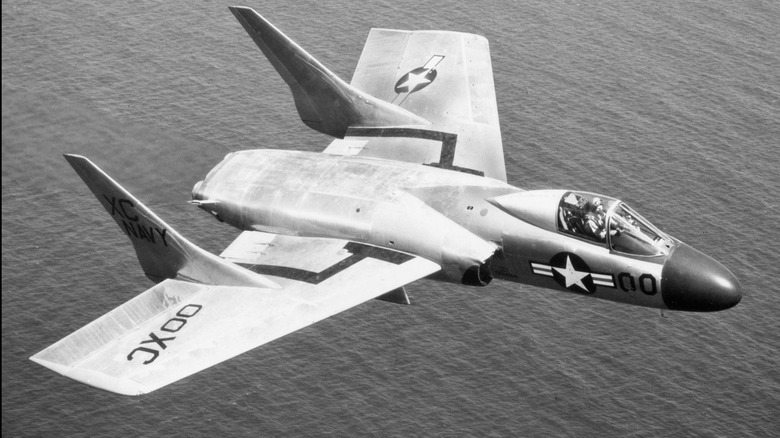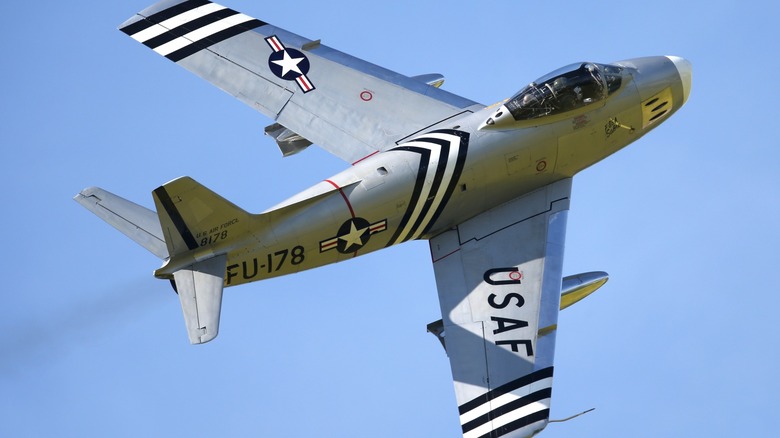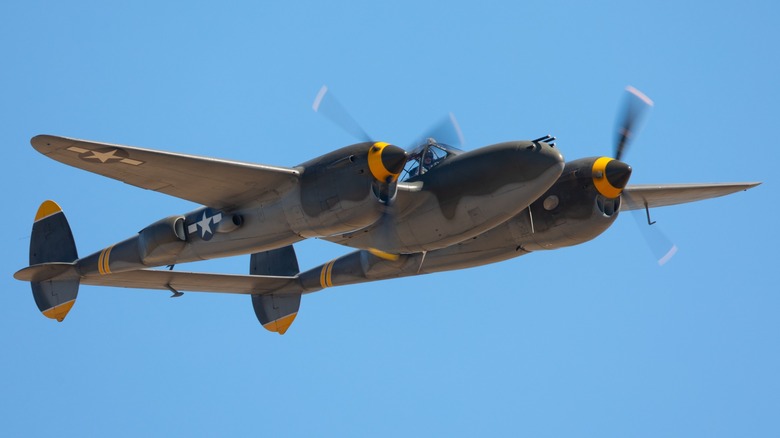10 Military Planes That Are Notoriously Difficult To Fly
English engineer, inventor, and aviator, Sir George Cayley stated to maintain any airplane in flight, three elements must be assured: the airplane's lift, sufficient propulsion, and stability. Military aircraft not only must meet these requirements but must do so at exceptionally high speeds while carrying bulky and heavy armaments, making them difficult to fly.
An aircraft is a complex machine that uses several engineering disciplines to achieve the principles of flight. These include aerodynamics and flight mechanics that determine the aircraft's shape; airframe structure; mechanical systems such as hydraulics, pneumatics, and landing gear; engine; electrical system; avionics such as communication and navigation; armament system; environmental systems such as cabin pressurization; and operational software.
Aircraft manufacturers use their own unique aircraft designs to meet these principles of flight and provide features and characteristics requested by the military. These differences make some aircraft more difficult to fly than others. Military pilots have reported that these planes are particularly difficult to fly.
Lockheed U-2 Spy Plane
The Air Force developed the U2 in the late '50s for use during the Cold War, as the U.S. government wanted to monitor Soviet military capabilities. Although the aircraft and its reconnaissance and surveillance missions were top secret, it became famous in May 1960 when the Soviet Union shot down the spy plane and captured its pilot, Francis Gary Powers.
Built by Lockheed Martin Aeronautics, the single-seat plane is powered by a General Electric F118-101 engine producing 17,000 pounds of thrust (upgraded from the Pratt and Whitney J75-P-13 non-afterburning turbojet engine) that provides a maximum speed of 410 mph and supports a payload of 5,000 pounds. The U2 has a flight ceiling exceeding 70,000 feet and the 2,950-gallon fuel capacity provides a range of over 7,000 miles (6,090 nautical miles).
Although the U2 is an exceptional aircraft, several factors make it one of the most difficult military airplanes to fly. Engineers designed the aircraft with an ultralight airframe to help it achieve high-altitude flight and a long range. A length of 63 feet and a wingspan of 105 feet give the U2 glider-like characteristics making it difficult to fly. A high stall speed relative to its maximum speed, and limited cockpit visibility make the airplane difficult to land. A chase car with another U-2 pilot is required to help the aircraft touch down. Takeoff is also challenging. To maintain balance, auxiliary wheels (pogos) are attached to each wing and drop away when the U2 goes airborne.
Lockheed SR-71 Blackbird
The Lockheed SR-71 Blackbird set the record for the fastest airplane in the world at 2,193 miles per hour (Mach 2.9) on 28 July 1976. The speed record still holds today, but the Blackbird also operated at extreme altitudes, setting a record of 85,069 feet in July 1976. Designed at Lockheed's Skunk Works to provide reconnaissance for the U.S. Air Force, the airplane and its pilot could survey up to 100,000 square miles (160,934 square kilometers) of territory in just one hour. Furthermore, the aircraft's stealth features made it difficult to detect with radar and the plane's acceleration allowed it to take evasive action when fired upon by a surface-to-air missile.
The SR-71 Blackbird's exceptional performance made the supersonic aircraft a challenge to fly. Pilots were required to resist high forces generated by acceleration in the early stages of flight. At high altitudes and speeds, flight control inputs became much more sensitive. Pilots were also required to wear pressure-resistant and heat-proof suits and helmets. Protective gear employed a unique oxygen system to allow normal breathing at high altitudes and protect against the canopy temperature reaching 600 degrees Fahrenheit at Mach 3 speeds.
Buz Carpenter, SR-71 program pilot commented, "The aircraft had a heavy control stick (it was hard to move) and powerful acceleration pushed you against the seat during takeoff. Yet, it was a delicate aircraft in that you had to carefully handle the controls at such high speeds."
Vought F4U-4 Corsair
The Corsair F4U-4 (FAU-1) is considered one of the greatest fighters to participate in World War II. American aircraft company Vought designed the original Corsair making maximum speed and minimal air resistance top priorities. To achieve its goals, Vought engineers equipped the plane with the largest engine available at the time, the Prat and Whitney R2800 Double Wasp radial engine driving a 13-foot propeller. The large propeller required engineers to use an inverted gullwing design that provided propeller clearance from the ground.
The Corsair broke the speed record for a single-seat, single-engine, aircraft carrier fighter at the time, exceeding 400 miles per hour. Impressed with the plane's performance, the Navy requested Vought mass produce the fighter and by 1952 the manufacturer had produced nearly 13,000 aircraft. World War II records justified the numbers. By the end of the war, the American warplane shot down around 2,140 enemy fighters, scoring a kill ratio of 11:1 against Japanese adversaries.
Despite its success, the Corsair required constant attention to maintain control, even when cruising in smooth air at altitude. It was most challenging when landing the fighter on a moving aircraft carrier. The fast airplane had a stalling speed of just over 90 mph which required the pilot to be perfectly aligned to catch an arresting wire stretched across the flight deck and prevent the aircraft from rolling over. Landing was also made difficult by poor cockpit visibility limited by the location well to the rear of the fuselage.
Lockheed F-117 Nighthawk
The F-117 Nighthawk was a groundbreaking technological achievement in the pursuit of radar-invisible aircraft when it made its maiden voyage in 1981. The single-seat, subsonic twin-engine attack aircraft was the U.S. Air Force's first operational stealth aircraft. It participated in Operation Just Cause, Panama beginning in December 1989, and the 1991 Gulf War. Designed to penetrate enemy airspace undetected, the Nighthawk was a well-kept secret until the Air Force revealed it to the public in April 1990.
Lockheed built the Nighthawk with several state-of-the-art features that made it nearly impossible to detect. The aircraft shape was formed of unique angles designed to disperse 99% of radar emissions away from the source. In addition, the aircraft's body was coated with secret radar-absorbing materials and painted matte black to conceal it in the dark. Unique horizontal exhaust vents defused the heat from the Nighthawk's engines and significantly reduced its infrared signature. While its subsonic speed of 615 mph (Mach .92) might seem a disadvantage in combat with modern-day supersonic fighter jets, it made the aircraft difficult to detect acoustically.
These characteristics helped give the 65-foot-long, 29,000-pound Nighthawk a visible radar cross-section (RCS) of just 0.003 square meters, about the size of a small bird. However, the tradeoff of this stealthy design was aerodynamic instability. Pilots nicknamed the aircraft the "Wobblin' Goblin." Even with the quadruple-redundant computerized fly-by-wire system required just to take off, pilots claimed the F-117 Nighthawk was a challenge to keep in the air.
Lockheed F-104
Engineering design always involves trade-offs. The design of the F-104 was no exception. The engineers made compromises but still gave top priority to building an aircraft with speed, altitude, and maneuverability. Aviation historian Ray Panko, of the Pacific Aviation Museum in Hawaii, claimed, "The F-104 gave them the first two but sadly not the third." Pilots noted it was more like flying a missile than an aircraft. Even famous test pilot Chuck Yeager had a life-threatening incident flying an out-of-control F-104.
The U.S. Air Force began production in 1958 and initially used the jet to deter Chinese MiG-15 and MiG-17 fighters in Korea. Equipped with the powerful General Electric J79 engine, the F-104 was the first aircraft to fly twice the speed of sound (1,528 mph) and the first aircraft to climb to 100,000 feet after taking off under its own power.
To achieve the aircraft's goal of high speed, the F-104 had a long thin fuselage, short thin wings, a pointy nose, and a tiny, cramped cockpit with poor pilot visibility. These features helped reduce drag but made it less maneuverable. The plane shook and vibrated violently when revving up for takeoff, and the small wings located at the top of the tail created turbulence in flight. The instability made the aircraft difficult to control at low speeds and at high angles of attack during a climb. Although the needle-nosed F-104 was officially named the Starfighter, pilots called it "the missile with a man in it."
McDonnell Douglas (Boeing) AV-8B Harrier II
The AV-8B Harrier II is the only short takeoff, vertical landing (STOVL) jet aircraft currently flying for the U.S. military. It's a critical component of the Marine Corps, supporting the troops in adverse conditions, and has undergone a series of improvements increasing safety, range, and lethality since the original of the 1960s. A Rolls Royce Pegasus F402-RR-406 turbofan engine produces 22,000 pounds of thrust allowing the plane to hover like a helicopter and achieve a near-supersonic maximum speed of 673 mpg.
The Marines use the AV-8B Harrier II for a variety of missions including attacking surface and air targets, reconnaissance, escorting helicopters, and air-to-air defense. The aircraft is equipped with armaments including a 4x AIM-9 Sidewinder, Paveway laser-guided bombs, and a GAU-12 25 mm cannon, among others.
Although the AV-8B Harrier II flies like most jets once airborne, the take-off and landing phase makes it a difficult aircraft to fly. Marine Lt. Col. Rob Kuckuk who flew an AV-8B II Plus Harrier for the Marines said, "I don't think Harriers are more difficult to fly than any other airplane. It's true: It requires constant attention. The take-off and landing phase is much more difficult than any other aircraft." The accident record confirms the risks. The AV-8B had 11.44 accidents per 100,000 flight hours, while the F/A-18 Hornet fighter experienced only three. Nevertheless, the AV-8B Harrier II will remain operational with the U.S. Marine Corps until 2029.
AH-64 Apache Helicopter
Many consider the Boeing AH-64 Apache helicopter to be the most advanced military aircraft produced today and the most successful attack helicopter in history. The helicopter has dominated many battlefields from the Gulf War to the Iraq War with some unique features. The aircraft is built with a space between the two General Electric T700 turboshaft engines reducing the chance of both being hit during an assault. The rotor blades will continue to operate when damaged, and its armor will repel a hit from a 23 mm round.
The tandem-seat Apache is nicknamed the "flying tank" for its impressive armor, including an M230A1 Hughes automatic 30 mm cannon, anti-armor missiles, and Hydra-70 2.75-inch rockets. In addition to the standard weapons systems, the AH-64D/E models incorporate the latest navigation, sensor, and communications equipment, upgraded from previous Apache versions. These include an improved Modernized Target Acquisition Designation Sight/Pilot Night Vision System (MTADS/PNVS) and an updated Small Tactical Terminal radio providing LINK 16 capability for communicating in a joint environment.
The technically advanced aircraft requires talent and skill to successfully fly. Former British Army Air Corps pilot Ed Macy who flew the Apache for five years with the UK's Army Air Corps as a pilot, captain, and flight commander, calls the helicopter: "the world's most sophisticated hunter-killer." Flight qualification requires completing an intense 18-month Apache course that has discouraged even the most experienced pilots and instructors who eventually dropped out.
Vought F7U Cutlass
Bringing a heavy, high-speed jet to a stop on a flight deck measuring about 500 feet long by snagging the tailhook on one of four arresting wires is a difficult task for most U.S. Navy pilots but an even more demanding challenge for the F7U Cutlass. David Tussey, former US Naval Aviator, commented, "It [F7U Cutlass] was just so poorly designed and had such terrible engines, that they were damn near impossible to land on a carrier."
Produced from 1948 to 1955, the unconventional design of the F7U Cutlass differed from all other naval aircraft at the time. Sans tail, the expansive swept wings with an area totaling 496 square feet were almost as long from the leading to the trailing edge as from the fuselage to the wing tip. The steerable nose gear placed the pilot 14 feet in the air, gave the aircraft an awkward-looking tilt backward, and tended to collapse during carrier landings. The F7U Cutlass was the first Naval aircraft with a 3,000 pounds per square inch, high-pressure hydraulic system.
However, the hydraulics constantly leaked and lost pressure, the engines lacked power, and other immature systems were subject to frequent failures making the aircraft both difficult and dangerous to fly. In 1957, after 55,000 hours of cumulative flight time, the Cutlass recorded the most accidents among all Navy swept-wing fighters with 78 accidents, and one-quarter of airframes lost.
North American F-86 Sabre Fighter
The F-86 Sabre Fighter is considered by many to have been one of the best fighter aircraft in the Korean War. It was built and flown during the period when military aircraft transitioned from propellers to jet engines making the design difficult for engineers and flight a challenge for pilots.
Propeller planes fly at much slower speeds than jet aircraft and tend to be stable. When knocked off course by a gust of wind, they will usually return to their original flight path. Jets, on the other hand, fly at much higher speeds and are inherently unstable. Military fighters are designed to be flown with the aid of a flight computer and generally are impossible for a human to control without them. Jet pilots attend intense training, must have lightning-fast reflexes, and withstand the high G-forces generated during high-speed maneuvers.
In addition to learning how to fly jets during the Korean War, pilots faced the challenge of adapting to the idiosyncrasies of the F-86 Sabre. The aircraft had distinct design features including swept wings and an all-flying tail or fully movable aircraft stabilizer. The jet lacked leading-edge slats that allowed the wing to operate at a higher angle of attack. The F-86 Sabre tended to over-rotate on take-off, a performance flaw that resulted in a high accident rate. One Sabre over-rotated on take-off at the Golden West Sport Aviation Air Show in Sacramento, California, crashed into a Farrell's Ice Cream Parlor and killed 22 people.
Lockheed P-38 Lightning
Most military historians agree that the Lockheed P-38 Lightning was one of the most successful American fighter aircraft in World War II. It featured a more advanced and adaptable design than two of its closest U.S. rivals, the North American P-51 Mustang and the Republic P-47 Thunderbolt, and set records with America's two top WWII aces: Richard "Dick" Ira Bong (40 kills) and Maj. Thomas McGuire (38 kills).
The single-seat aircraft measured 37 feet, 10 inches long and 12 feet, 10 inches high with a wingspan of 52 feet, and weighed 12,800 pounds with a maximum takeoff weight of 21,600 pounds. Powered by two Allison V-1710-89/91 counter-rotating engines, each producing 1,475 horsepower, the fighter reached a maximum velocity of 414 mph with a range of 450 miles under average flying conditions. The P-38 Lightning carried up to 4,000 pounds of bombs, rockets, or depth charges, and was equipped with one 20mm cannon and four .50 caliber machine guns mounted in the nose.
When introduced, the P-38 Lightning was the fastest production airplane in the world, and it remained one of the fastest climbers (3200 ft/min at sea level and 2300 ft/min at 20,000 feet) until the end of the war. Military pilots stated that the P-38 Lightning's flight characteristics were similar to other single-engine high-performance fighters. However, training to use the aircraft required twice as long to master. Furthermore, pilots claimed flying the P-38 became more difficult and even violent and dangerous when underwing armaments were added.
